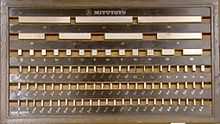Standard (metrology)

In the science of measurement, a standard is an object, system, or experiment that bears a defined relationship to a unit of measurement of a physical quantity.[1] Standards are the fundamental reference for a system of weights and measures, against which all other measuring devices are compared. Historical standards for length, volume, and mass were defined by many different authorities, which resulted in confusion and inaccuracy of measurements. Modern measurements are defined in relationship to internationally-standardized reference objects, which are used under carefully controlled laboratory conditions to define the units of length, mass, electrical potential, and other physical quantities.
Hierarchy of standards

There is a three-level hierarchy of physical measurement standards. At the top of the tree are the master standards - these are known as primary standards. Primary standards are made to the highest metrological quality and are the definitive definition or realization of their unit of measure.[2] Historically, units of measure were generally defined with reference to unique artifacts which were the legal basis of units of measure. A continuing trend in metrology is to eliminate as many as possible of the artifact standards and instead define practical units of measure in terms of fundamental physical constants, as demonstrated by standardized technique. One advantage of elimination of artifact standards is that inter-comparison of artifacts is no longer required. Another advantage would be that the loss or damage of the artifact standards would not disrupt the system of measures.
The next quality standard in the hierarchy is known as a secondary standard. Secondary standards are calibrated with reference to a primary standard.[2]
The third level of standard, a standard which is periodically calibrated against a secondary standard, is known as a working standard.[2] Working standards are used for the calibration of commercial and industrial measurement equipment.
Primary reference standards

An example of a primary standard is the international prototype kilogram (IPK) which is the master kilogram and the primary mass standard for the International System of Units (SI). The IPK is a one kilogram mass of a platinum-iridium alloy maintained by the International Bureau of Weights and Measures in Sèvres, France.
Another example is the unit of electrical potential, the volt. Formerly it was defined in terms of standard cell electrochemical batteries, which limited the stability and precision of the definition. Currently the volt is defined in terms of the output of a Josephson junction, which bears a direct relationship to fundamental physical constants.
In contrast, the reference standard for the meter is no longer defined by a physical object. In 1983, the standard meter was redefined as the distance light travels in a vacuum during 1/299,792,458 of a second.
Secondary reference standards
Secondary reference standards are very close approximations of primary reference standards. For example, major national measuring laboratories such as the US's National Institute of Standards and Technology (NIST) will hold a national standard kilogram, which is periodically calibrated against the IPK.
Working standards
Although the SI definition of the "meter" is based on a laboratory procedure combining the speed of light and the duration of a second, a machine shop will have a physical working standard (gauge blocks for example) that are used for checking its measuring instruments. Working standards and certified reference materials used in commerce and industry have a traceable relationship to the secondary and primary standards.
References
See also
- History of measurement
- International System of Units
- Measurement
- Measurement uncertainty
- Measuring instrument
- Metre
- Units of measurement
- Watt balance